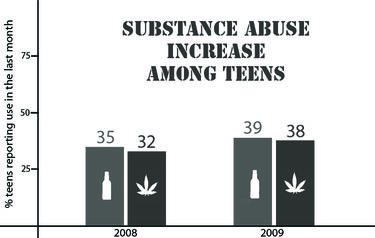Reversing a budding trend
Study shows uptick in substance abuse
Just a few percentage points can make all the difference when it comes to illegal substances. Among teens, marijuana and alcohol abuse rates are rising for the first time in ten years, according to a study by the Partnership for a Drug-Free America. The 2009 Partnership/MetLife Foundation Attitude Tracking study, which recorded the number of teens who had reported use within the past month, found that alcohol use among teens increased from the 32 percent measured in 2008. Reported marijuana use shot up from 32 percent of teens to 39 percent of teens in the same time. Candice Besson of the Partnership for a Drug-Free America attributed this trend to several different factors, including a decrease in federally-funded prevention programs and an increase in the portrayal of substance abuse in movies and television.
The Partnership for Drug-Free America attributes a large part of the trend to pop culture. Top-grossing films like "The Hangover", "Pineapple Express", etc. have brought alcohol and marijuana use into the mainstream to such an extent that illegal and dangerous activities are portrayed not only as a classic form of teenage rebellion but as harmless, as a comedy, an innocent and goofy rite of passage whose dangers are irrelevant. "There is an increase in social cues in pop culture," notes Besson. And the cues won't let up. For a generation that spends 22.4 hours per week in front of the television and 31 hours online, the onslaught of pro-drug and alcohol media shows no signs of abatement.The rise is also contagious - countless studies have found that teens abuse substances because of peer pressure or peer acceptance, and now that the trend is on an upward streak, it will only exacerbate, according to the partnership. Once a trend begins an upward swing, the Partnership warns, it will likely not slow down. We have seen the inverse of this trend in the previous decade's steady decline. Now, the dilemma remains: We must reverse what is likely going to be an upswing in harmful activity that will have long-term health risks on our generation.
Unfortunately, this issue has not been recognized nationally save for a few stray articles on the increase. And so far, there's been no large-scale action taken to combat what is likely to be a pervasive trend. According to Besson, there is a "lack of federal funds for prevention education programs." Granted, in a tight economic climate, reallocation of funds for programs that, from the standpoint of the federal government are relatively insignificant, are not the first among budget priorities. So now, the effort to fight substance abuse must come from places in addition to health class.
Where to begin to reverse this damaging trend? Well, more comprehensive drug education is a start. It's a Sisyphean task to reverse the effects of countless YouTube videos and "slacker" movies. The Partnership for a Drug-Free America has chosen to shift their focus of prevention to the same place where teens are exposed to misleading media: the home. They have chosen, instead, to direct their next prevention project toward parents. "Our mission is for parents to prevent, intervene in, treat drug and alcohol use by their children in order to reduce use," says Besson. This may come in a form as simple as encouraging parents to discuss the impact and consequences of substance abuse with their children at home. Just as negative messages filter in through media at home, so should accurate information about the illegality and danger of teen drug and alcohol abuse come from home.
Parents must not just focus on warnings, however - they must be vigilant in teaching their children the basic media literacy skill of asking: What does this movie/TV show want me to think? According to this, how should I act? For a generation that spends more time in front of screens than ever before, gaining the tools to decipher the onslaught of negative messages is crucial. And health education at home on the basic facts of drug use is dire during a time of cutbacks to school funding - which includes funding for prevention and health education programs.
The Partnership's initiative is more than a call to action for parents to help their teens make safe decisions - it's a grassroots initiative to solve an impending substance abuse spike to which the federal government and media are indifferent. And though it is ultimately up to teens to avoid a destructive trend of drug use that will have long-term health repercussions, parents need to also provide honest, accurate information regarding drug use to teens.
Tags: print
Nellie Beckett. More »
Comments
No comments.
Please ensure that all comments are mature and responsible; they will go through moderation.
